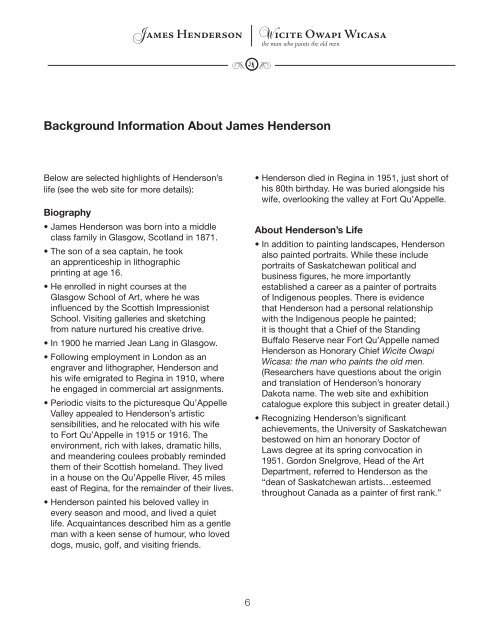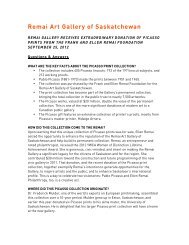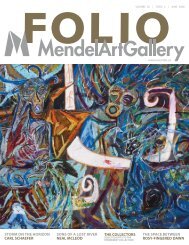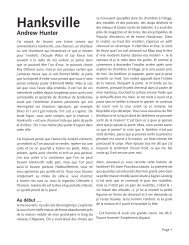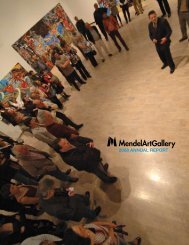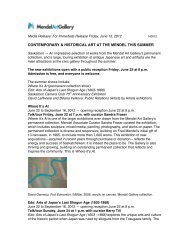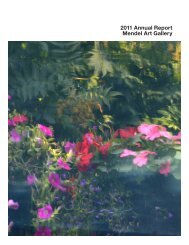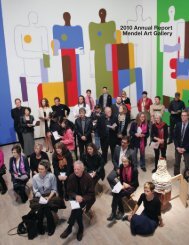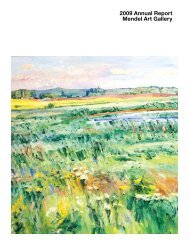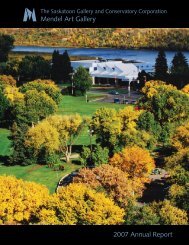DOWNLOAD the Educator's Guide here - Mendel Art Gallery
DOWNLOAD the Educator's Guide here - Mendel Art Gallery
DOWNLOAD the Educator's Guide here - Mendel Art Gallery
You also want an ePaper? Increase the reach of your titles
YUMPU automatically turns print PDFs into web optimized ePapers that Google loves.
Background Information About James Henderson<br />
Below are selected highlights of Henderson’s<br />
life (see <strong>the</strong> web site for more details):<br />
Biography<br />
• James Henderson was born into a middle<br />
class family in Glasgow, Scotland in 1871.<br />
• The son of a sea captain, he took<br />
an apprenticeship in lithographic<br />
printing at age 16.<br />
• He enrolled in night courses at <strong>the</strong><br />
Glasgow School of <strong>Art</strong>, w<strong>here</strong> he was<br />
influenced by <strong>the</strong> Scottish Impressionist<br />
School. Visiting galleries and sketching<br />
from nature nurtured his creative drive.<br />
• In 1900 he married Jean Lang in Glasgow.<br />
• Following employment in London as an<br />
engraver and lithographer, Henderson and<br />
his wife emigrated to Regina in 1910, w<strong>here</strong><br />
he engaged in commercial art assignments.<br />
• Periodic visits to <strong>the</strong> picturesque Qu’Appelle<br />
Valley appealed to Henderson’s artistic<br />
sensibilities, and he relocated with his wife<br />
to Fort Qu’Appelle in 1915 or 1916. The<br />
environment, rich with lakes, dramatic hills,<br />
and meandering coulees probably reminded<br />
<strong>the</strong>m of <strong>the</strong>ir Scottish homeland. They lived<br />
in a house on <strong>the</strong> Qu’Appelle River, 45 miles<br />
east of Regina, for <strong>the</strong> remainder of <strong>the</strong>ir lives.<br />
• Henderson painted his beloved valley in<br />
every season and mood, and lived a quiet<br />
life. Acquaintances described him as a gentle<br />
man with a keen sense of humour, who loved<br />
dogs, music, golf, and visiting friends.<br />
• Henderson died in Regina in 1951, just short of<br />
his 80th birthday. He was buried alongside his<br />
wife, overlooking <strong>the</strong> valley at Fort Qu’Appelle.<br />
About Henderson’s Life<br />
• In addition to painting landscapes, Henderson<br />
also painted portraits. While <strong>the</strong>se include<br />
portraits of Saskatchewan political and<br />
business figures, he more importantly<br />
established a career as a painter of portraits<br />
of Indigenous peoples. T<strong>here</strong> is evidence<br />
that Henderson had a personal relationship<br />
with <strong>the</strong> Indigenous people he painted;<br />
it is thought that a Chief of <strong>the</strong> Standing<br />
Buffalo Reserve near Fort Qu’Appelle named<br />
Henderson as Honorary Chief Wicite Owapi<br />
Wicasa: <strong>the</strong> man who paints <strong>the</strong> old men.<br />
(Researchers have questions about <strong>the</strong> origin<br />
and translation of Henderson’s honorary<br />
Dakota name. The web site and exhibition<br />
catalogue explore this subject in greater detail.)<br />
• Recognizing Henderson’s significant<br />
achievements, <strong>the</strong> University of Saskatchewan<br />
bestowed on him an honorary Doctor of<br />
Laws degree at its spring convocation in<br />
1951. Gordon Snelgrove, Head of <strong>the</strong> <strong>Art</strong><br />
Department, referred to Henderson as <strong>the</strong><br />
“dean of Saskatchewan artists…esteemed<br />
throughout Canada as a painter of first rank.”


